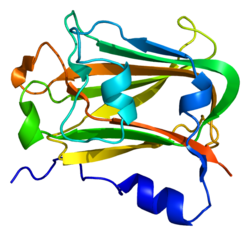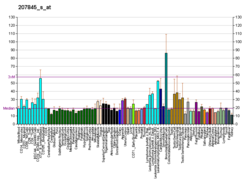From Wikipedia, the free encyclopedia
Anaphase-promoting complex subunit 10 is an enzyme that in humans is encoded by the ANAPC10 gene .[ 5] [ 6] [ 7]
Template:PBB Summary
Interactions
ANAPC10 has been shown to interact with CDC27 ,[ 8] [ 9] Mothers against decapentaplegic homolog 3 [ 10] Mothers against decapentaplegic homolog 2 .[ 10]
References
^ a b c GRCh38: Ensembl release 89: ENSG00000164162 – Ensembl , May 2017^ a b c GRCm38: Ensembl release 89: ENSMUSG00000036977 – Ensembl , May 2017^ "Human PubMed Reference:" . National Center for Biotechnology Information, U.S. National Library of Medicine .^ "Mouse PubMed Reference:" . National Center for Biotechnology Information, U.S. National Library of Medicine .^ Grossberger R, Gieffers C, Zachariae W, Podtelejnikov AV, Schleiffer A, Nasmyth K, Mann M, Peters JM (Jun 1999). "Characterization of the DOC1/APC10 subunit of the yeast and the human anaphase-promoting complex". J Biol Chem . 274 (20): 14500–7. doi :10.1074/jbc.274.20.14500 . PMID 10318877 . {{cite journal }}: CS1 maint: unflagged free DOI (link )^ Wiemann S, Weil B, Wellenreuther R, Gassenhuber J, Glassl S, Ansorge W, Bocher M, Blocker H, Bauersachs S, Blum H, Lauber J, Dusterhoft A, Beyer A, Kohrer K, Strack N, Mewes HW, Ottenwalder B, Obermaier B, Tampe J, Heubner D, Wambutt R, Korn B, Klein M, Poustka A (Mar 2001). "Toward a catalog of human genes and proteins: sequencing and analysis of 500 novel complete protein coding human cDNAs" . Genome Res . 11 (3): 422–35. doi :10.1101/gr.GR1547R . PMC 311072 PMID 11230166 . ^ "Entrez Gene: ANAPC10 anaphase promoting complex subunit 10" .^ Vodermaier, Hartmut C; Gieffers, Christian; Maurer-Stroh, Sebastian; Eisenhaber, Frank; Peters, Jan-Michael (Sep 2003). "TPR subunits of the anaphase-promoting complex mediate binding to the activator protein CDH1". Curr. Biol . 13 (17). England: 1459–68. doi :10.1016/S0960-9822(03)00581-5 . ISSN 0960-9822 . PMID 12956947 . ^ Gmachl, M; Gieffers C; Podtelejnikov A V; Mann M; Peters J M (Aug 2000). "The RING-H2 finger protein APC11 and the E2 enzyme UBC4 are sufficient to ubiquitinate substrates of the anaphase-promoting complex" . Proc. Natl. Acad. Sci. U.S.A. 97 (16). UNITED STATES: 8973–8. Bibcode :2000PNAS...97.8973G . doi :10.1073/pnas.97.16.8973 . ISSN 0027-8424 . PMC 16806 PMID 10922056 . ^ a b Nourry, Claire; Maksumova Lola; Pang Mona; Liu Xiaohong; Wang Tongwen (May 2004). "Direct interaction between Smad3, APC10, CDH1 and HEF1 in proteasomal degradation of HEF1" . BMC Cell Biol . 5 . England: 20. doi :10.1186/1471-2121-5-20 . PMC 420458 PMID 15144564 . CS1 maint: unflagged free DOI (link )
Further reading
External links
Template:PBB Controls







